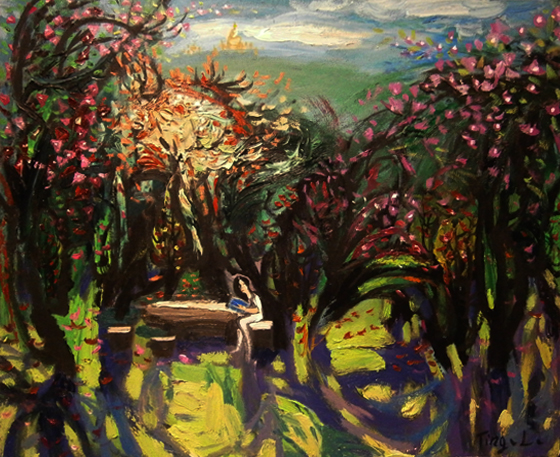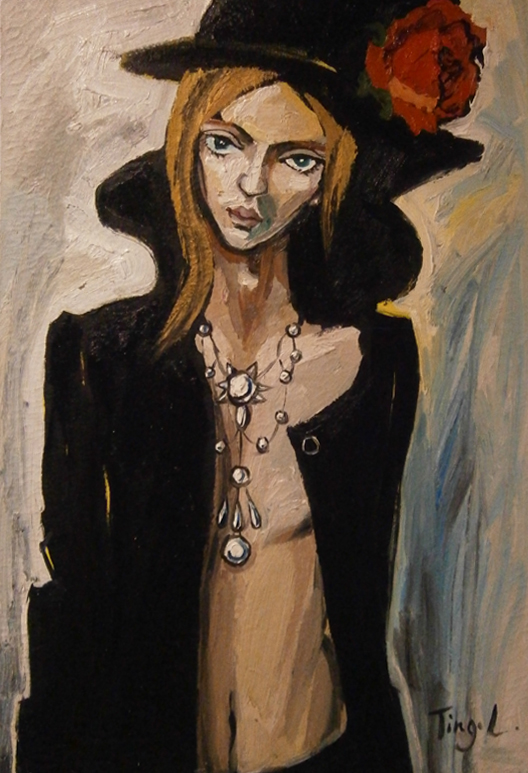
Ting Lui
The exhibition, A Breeze Comes from 'Meng Bana Xi,' displays recent oil on canvas works whose quirkiness and individuality are rare in an era of globalization, when standardized ideas take on a generic identity that reveals few personal hints about the artist who creates them. The twenty-four paintings on view provide a glimpse of purity undiluted by outside contemporary influences. Ting works in a small isolated village in South China, near the Myanmar (Burmese) border, separate from the hip and the trendy burgeoning yet government "guided" art centers of Shanghai and Beijing. These works are rife with messages and feelings that seem on the brink of exploding. Her demonstrative approach, which harks to the era when both the German Expressionists and Edvard Munch gave voice to their dark feelings of foreboding and anxiety, is viewed by local Chinese authorities with suspicion. Ting fails to follow the official lines whose boundaries determine acceptable styles and content for contemporary art in China.
It is perhaps difficult to realize that many women artists in the West are confronted with oppression as well. Like Ting they keep following their star, which is not so much a choice or a matter of principle for authentic artists, but rather a necessity. Ting paints what she feels, in an intense impasto in a style whose thick paint and black outlines tend to hold the forms captive. The artist's technique hints that her powerful poetic spirit is rebelling against the negative constraints in society that darken her outlook. Although she lives in a small village, her life is not simple or easy, since repression of the spirit tends to put a hood over one's feelings. Perhaps by releasing the forms from the strong suppressing outlines, she might discover that the shapes would breathe more freely and forge a path that would enable her to free her mind.

Ting has painted a number of works of young women, and boys who resemble young women. Some of the works may possibly be self-portraits, while others may reflect the same gender ambiguity that is at issue today in Western cultures. Gender seems to be flip-flopping of its own irrepressible accord; the artist is aware of these nuances, she has a feeling for the hidden and the mysteriously suppressed, which seems to inspire her. "The Boy Wearing A Red Flower" (27.5 x 39," 2016 - 2017) evokes the look of a twenty-something young woman; in "The King of Wheat," the semi-nude unisex subject's long black hair and budding breasts hint at female characteristics and anatomy. Similarly, the figure in the painting entitled "Notebook" conjures both male and female vibes, which lend the piece a surprisingly edgy aura that parallels the turbulent transgender themes currently in the air in the West.
Despite the pressures in her society, Ting seems to love life and to love the world. She sees everything in her surroundings as art subjects and she is not afraid of people. There are many images of figures in her works, although they are often solitary. She explores their personalities within settings and with items that hint at their likes and dislikes, such as a garden, a view seen from a window, a piece of fruit, or a flower tucked into the rim of a hat. Ting does not have an agenda; she paints what is around her, that which affirms her life. The artist paints the countryside, animals, examples of buildings, often churches, and forests with equal resolve. There is nothing coy about the artist’s attitude as she explores the gamut of themes in her daily life.
Ting frequently employs several strong colors in a single format to make an intense emotionally charged statement on benign themes. This strategy perhaps gives visual articulation to feelings of strain that are unacceptable to verbalize in a controlled culture. When she desaturates and limits some of her colors, the images, such as "Pearl Earrings" (a possible reference to Vermeer) or "Wind Song," are more subdued, contemplative. She seems to be investigating ways to work her way through various forms of expression, as young artists do when they are still hungry for the chance to explore many new topics and techniques. Ting might at some point begin to favor certain themes or colors above others, as she hones her interests in her quest for more specialized creative experience. Her works at this stage seem inspired by a mix of Gauguin's island themes, and the dark lines and intense hues of the German Expressionist painter Ernst Ludwig Kirchner.

It is not easy to be isolated from the currents of contemporary art, to feel one's way without the barometer of fellow artists' opinions. Often these opinions subtly point a way through one's conflicting proclivities that combine to extract the necessary choices and decisions. Ting's determination to realize her vision, her courage in the face of serious societal and cultural opposition, make her a model woman artist and a compatriot of all those whose search for truth provokes irrational opposition.
